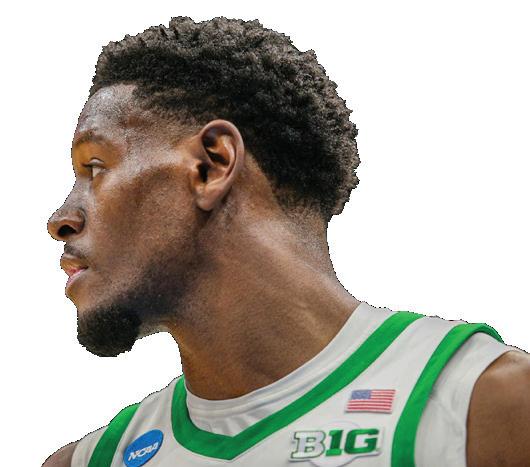MONDAY, SEPT. 29, 2025
Ducks men’s basketball bolsters roster with strong additions from transfer portal

Everything you need to know about the 2025 MTV VMAs

MONDAY, SEPT. 29, 2025
Ducks men’s basketball bolsters roster with strong additions from transfer portal

Everything you need to know about the 2025 MTV VMAs


Kurihara: You can pick up your gameday
Post-game laziness is no excuse for littering in Oregon
Oregon House’s failure to pass regulation bill on investor-owned utilities raises concerns for ratepayers, wildfire victims
Billie Corsetti News Reporter
The Oregon House’s Legislative Session officially adjourned June 27, killing chances for Senate Bill 926 to be passed. The bill would have implemented stricter regulation by the Public Utilities Commission (PUC) on investor-owned utilities and prohibited additional expenses onto consumers after wildfires.
The bill was created with bipartisan support, being introduced by Sen. David Brock Smith (R-Port Orford) and Sen. Chris Gorsek (D-Gresham), and intended to prevent IOU’s from recovering costs and expenses incurred by a court from wildfire victims after being found negligent and causing a wildfire. The bill defines “costs and expenses” as funds used by IOU’s to pay for settlements with victims, litigation fees, penalties or fines and other payments required by the court after being found at fault for a wildfire.
SB 926 would have also imposed conse-



EDITOR IN CHIEF
Tarek Anthony
PRINT MANAGING EDITOR
Ryan Ehrhart
DIGITAL MANAGING EDITOR
Ysabella Sosa
NEWS EDITOR
Reilly Norgren
INVESTIGATIONS EDITOR
Ana Narayan
A&C EDITOR
Claire Coit
SPORTS EDITOR
Jack Lazarus
OPINION EDITOR
Gracie Cox
PHOTO EDITOR
Saj Sundaram
COPY CHIEF
Olivia Ellerbruch
VIDEO EDITOR
Jake Nolan
PODCAST EDITOR
Stephanie Hensley
SOCIALS EDITOR
Ysabella Sosa
VISUALS EDITOR
Noa Schwartz
DESIGN EDITOR
Adaleah Carman
DESIGNERS
Eva Andrews
Maya Gooneratne
BUSINESS
PUBLISHER AND PRESIDENT
Eric Henry (X317) ehenry@dailyemerald.com
VP OPERATIONS
Kathy Carbone (X302) kcarbone@dailyemerald.com
DIRECTOR OF SALES & DIGITAL MARKETING
Shelly Rondestvedt (X303) srondestvedt@dailyemerald. com
CREATIVE & TECHNICAL
DIRECTOR
Anna Smith (X327) creative@dailyemerald.com
ACCOUNT EXECUTIVES
Torin Chevalier
Camcole Pereira
Ava Stephanian
Elliot Byrne
THE DAILY EMERALD
The Daily Emerald is published by Emerald Media Group, Inc., the independent nonprofit media company at the University of Oregon. Formerly the Oregon Daily Emerald, the news organization was founded in 1900.
Emerald Media Group 1395 University St.,#302 Eugene, Or 97403 (541)-346-5511

As a clearly marked journalist, I was tracked anyway — and that should concern everyone who values free speech.
Tarek Anthony Editor-In-Chief
As a journalist, I’ve covered dozens of protests. I’ve stood on sidewalks, run down streets and entered occupied buildings. I’ve witnessed many surveillance tactics — school police, administrators, even SWAT. But last Tuesday night was different — not because of the protest itself, which was largely peaceful, but because of what happened afterward.
Earlier in the day, I’d heard about an anti-ICE protest scheduled outside the federal building in downtown Eugene, at the corner of East 7th Avenue and High Street. Protesters planned to remain there from 2 p.m. until 2 a.m.
The scene stayed largely peaceful throughout the day, aside from a brief skirmish in the evening that resulted in three detentions. Around 8 p.m., our photo editor texted me: officers were gearing up with riot gear. He added, “They’ve got police drones up, and they’re following people to their cars.”
Anticipating a possible escalation, I grabbed my bright green press jacket — clearly labeled — and drove downtown.
When I arrived, I saw three or four drones hovering above a several-block radius around the protest. At first, I didn’t think much of it. I’ve seen drones used at protests before for crowd surveillance and safety. I walked around the building and stood on a public sidewalk for about two hours with other reporters and roughly 30 protesters.
Aside from the occasional honking of supportive cars and a few antagonists yelling from the street, it was calm. Certainly, nothing seemed to justify riot gear or gas masks.
Eventually, things began to wind down. Our photo editor headed home. I crossed the street back to my car, and that’s when I noticed a police drone hovering directly above it. I moved to another side of the building, and a second drone immediately tracked me.
As I sat in my car, I received a message from our photo editor: a drone had followed him as he walked all the way to his apartment — nearly half a mile away. Moments later, I looked up toward his building and saw a drone zooming back toward the protest area.
I left and drove down East Broadway street. Through my sunroof, I watched as two drones followed my car down the street. About half a mile away, the glowing red and green lights disappeared — presumably they’d turned back.
I’ve never been particularly alarmed by government surveillance. I understand its role in maintaining public safety — to an extent. But being followed home by two drones — just for standing on a public sidewalk during a mostly peaceful protest — crossed a line I’d never imagined.
What’s even more disturbing is that they followed journalists home — despite my clearly marked cre-
dentials. But it wasn’t just us. It seemed indiscriminate. Anyone in the area was a target. The crime? Being present in a public space where free speech was being exercised.
Whether they truly knew I was a journalist or not is unanswerable. But to be honest, it doesn’t matter because the message was clear. It was an obvious intimidation tactic for journalists and protestors alike.
As I drove home, my thoughts were scattered. I wasn’t afraid of arrest — I knew I was fully within my rights as a reporter and private citizen. But the recurring questions were:
What file did my license plate number go into?
What report said “white male entered vehicle, exited via Broadway”?
Where did my name end up?
What list am I on now — at the Federal Protective Service, or elsewhere?
In the grand scheme of things? Maybe nowhere. Probably nothing. But the fact that I even have to ask or that I’m spending my evening writing this column instead of editing articles is, in itself, a frightening sign of where we are.
I’m lucky. I’m a U.S citizen. But what if I had been an undocumented or international student studying journalism? What if simply covering a protest could put someone’s visa, freedom or education at risk?
And it gets worse.
Recently, Eugene installed a network of license plate readers across the city that can map your every move. Advocates say it’s for catching criminals, which is true. But between those and the drones, I didn’t feel observed — I felt stalked.
The Eugene Police Department confirmed to KLCC that the drones were theirs. This experience calls for greater transparency from our local agencies about their cooperation with federal authorities — especially at a time when freedom of speech feels increasingly at risk.
I’m not writing this to make a political statement. I’m writing this as a wake-up call. Because ultimately this particular subject isn’t about right or left, or ICE or no ICE. It’s about the fact that a journalist wearing a press jacket was followed home by law enforcement tracking technology, from where he was exercising two of the rights that American democracy was built upon.
And if that doesn’t shake you — ask yourself: What happens next time you show up?

Tarek Anthony is a senior studying journalism and political science. Before becoming editor-in-chief, he served as the Emerald’s investigations editor and newsletter producer, and previously reported on crime and local government in Eugene. His dream job is to cover nuclear conflict and terrorism in the Middle East.





















Senate Bill 926 was still in committee when the 2025 Legislative Session was adjourned, effectively killing the bipartisan wildfire victim protection bill.
quences onto IOU’s with remaining unsettled debt due to causing wildfires. Section 3, an amendment introduced by the Senate, prohibited companies from paying and distributing ownership, stock, dividends and other investments.
The House revised this section and instead required companies to immediately request an investigation by the Public Utilities Commission if they still haven’t satisfied a judgement but wish to work with investors. The Oregon Citizens’ Utility Board claimed in their testimony that although they supported the protection of ratepayers, these harsh financial restrictions would affect the safety of consumers, resulting in their opposition.
Another amendment by the House would have required IOU’s to apply for an annual Safety Certification that the PUC would only issue if the company implemented a plan of wildfire safety policies and practices. In an email to The Daily Emerald, PUC Policy Advisor Garrett Martin described how the proposed Safety Certification would have modified the scope of PUC’s regulation.
“The Safety Certification concept, proposed in SB 926, went beyond reviewing the performance of utility programs and would have required internal safety culture assessments
“Garrett Martin PUC Policy Advisor
“ Going forward, there is an opportunity for the legislature to collaborate with stakeholders in crafting wildfire-related policies that foster utility accountability and safety.
and other continuous improvement practices meant to address how rapidly the wildfire risk is changing,” Martin said. “When the risk – and the science and practices related to managing that risk – are changing very quickly, it is important to ensure utilities are rapidly and continuously learning.”
Although SB 926 failed, Oregon lawmakers were able to address growing wildfire concerns by passing a revenue-raising emergency fund of almost $300 million. Oregon lawmakers have promised to continue to fight for stable rates, victim compensation and more safety policies.
If future legislative sessions vote and pass bills like SB 926, Martin states that PUC would create more standards that hold utilities accountable, and research further into preventive methods and recovery for victims. “Going forward, there is an opportunity for the legislature to collaborate with stakeholders in crafting wildfire-related policies that foster utility accountability and safety.”
The question of regulation surrounding IOU’s brings light to an increasingly common answer for some cities: publicly owned utilities. POU’s are operated by a board with members being elected by the public, which promotes more
direct oversight of rates, policies and recoveries. Oregon has 38 POU’s, making it one of the top states in the country.
The Eugene Water and Electric Board, a Eugene-based POU that serves about 200,000 people in Eugene and the McKenzie River area, did not take a position on SB 926.
“EWEB is a community-owned utility, governed by a five-member Board of Commissioners who are elected by the people of Eugene. The bill wouldn’t have affected EWEB and we didn’t take a position on it,” EWEB spokesperson Aaron Orlowski said.
Although EWEB and other POU’s in Oregon have managed to keep rates relatively stable, the country has seen steadily rising rates due to international markets and energy consumption.
The safety procedures of EWEB and Lane Electric Coop, a member-owned utility in Eugene, have also been questioned since the Holiday Farm Fire of 2020. They have faced ongoing legal battles from multiple businesses and individuals who’ve claimed that delays and lack of responses from EWEB and LEC contributed to the devastating fire.

A recap of the 2025 MTV Video Music Awards: winners, history, performance and more.
By Everette Cogswell Arts & Culture Writer
The Music Television’s Video Music Awards took place on Sept. 7, and it was a night full of wins, losses, performances and more. With artists ranging from Ariana Grande to Megan Moroney to Alex Warren, the 2025 VMAs were quite the event.
The Video Music Awards, VMAs, began in 1984 at the Radio City Music Hall. MTV wanted to create its own prestigious award to honor the best music videos, since the Music Television brand was centered around music videos.
Although the VMAs might not be considered as prestigious as the Grammys, it is still a very high honor for artists and musicians. Since then, many iconic moments have taken place at this award show, such as the 2009 VMAs when Kanye West infamously interrupted Taylor Swift’s win to shout out Beyoncé.
This year, the performances and musicians spanned across the board. Doja Cat, Jelly Roll, Sombr and Sabrina Carpenter, among others, accompanied the awards. Lady Gaga was the most nominated artist of the night with 12 nominations and was also the biggest winner, taking home four awards.
The artist who took home the most prestigious award of the night, however, was Ariana Grande. Grande was awarded Video of the Year for her musical short film “brighter days ahead,” shortly after winning the Best Pop award. In her acceptance speech, she said, “Thank you first and foremost to my fans, I love you with every fiber of my being.” She also took home Best Longform Video for “brighter days ahead.”
Other notable awardees include Alex Warren for Best New Artist, Blackpink for Best Group and Ricky Martin for the Latin Icon Award, along with Megan Moroney’s “Am I Okay” for Best Country, Busta Rhymes for the Rock the Bells Visionary Award and Best Album went to Sabrina Carpenter for “Short n’ Sweet.”
The part of the night that is most looked forward to by fans and viewers are the performances. This year, they did not disappoint. Doja Cat opened the night with an ‘80s-esque performance of her song “Jealous Type” with Kenny G. While the set and music were very strong, the stand-out quality of this performance was her dance and choreography. The background dancers had perfect onstage chemistry with Doja Cat, and the choreography was complex and matched the vibe of the set perfectly. Doja Cat is known for her immersive performances, and this show was the perfect way to start the award ceremony.
Tate McRae’s performance was also a highlight of the night, and she stood out. Also known for her stage presence, McRae’s performance of popular songs “Revolving Door” and “Sports Car” was outstanding. She included her iconic back-bend from the “Revolving Door” music video, which gained popularity on TikTok this past year. With a background in dance, McRae’s performances are always fun to watch.
The VMAs are always a memorable night of music, performances and honoring the talented musicians among us. While the VMAs might be considered more casual than other award ceremonies, the iconic statue of the astronaut that sits on top of these awards is a valuable tribute to the work of these artists.


From
hobbies to Whole Foods, the opinion desk has got you covered for what’s “hot” in fall term and what’s not.
By Opinion Desk
After a summer that was equal parts chaotic and uneventful, The Emerald’s opinion desk is back in town. We are more than ready to dive into the debates and happenings that get our blood pumping (whether from excitement or frustration) as the school year kicks off. From politics to style to housing woes to campus norms: we’ve got it all.
And if you want to share your own hot (but informed) takes, stay tuned! In the coming weeks, we will be inviting UO community members to have their opinions published by the Emerald. Every person on this campus has a right to be heard, and the opinion desk hopes to provide that outlet with upcoming Guest Columns.
But for the time being, let’s look forward to the term ahead, and see what’s hot, what’s not and what’s just… meh.
-Gracie
Cox, Opinion Editor
Nothing is better than curling up in a blanket, lighting a candle, opening a window and starting a new book. My recommended fall genres are thrillers, romances and classics. Hot people read. If you’re not reading, what exactly are you doing?
- Catalina Kurihara, Opinion Columnist
Fall is always for checking up on voter registration, fighting for democracy and voting in ALL elections – including special elections (mark your calendars; Nov 4th)!
- Aishiki Nag, Opinion Columnist
As I enter this term as a senior, there’s something bittersweet about going into my last fall term at UO. Thinking about the future is kind of hard when you want to embrace the beginnings of an ending.
- D Ortega, Opinion Columnist
There’s no worse feeling than wondering if your academic acquaintances still remember you. I want to say “hi” of course, but is it too awkward? I’m well aware we exchanged numbers over a year ago and that we only texted about our professor’s zany outfits, but what if we became besties anyway? I’ll just keep quiet and stick with the good ol’ “Radio Rebel” smirk to keep everyone on their toes. It’s simpler that way.
- Gracie Cox, Opinion Columnist
I hate that the most convenient grocery store on the west side of campus is Whole Foods. It's expensive and doesn’t have half the things I’m looking for when I need them!
- Zaida Ferguson, Opinion Columnist
I’d like to be able to walk home after a lecture and have the sun still be out. Plus, my stomach always gurgles during those 4 p.m. lectures because it’s dinner time!
- Leo Heffron, Associate Opinion Editor











































Catalina Kurihara is a second-year Political Science and Public Relations double major with a minor in Science Communication. In her free time, Catalina loves deep diving into pop culture and spending time with her dogs.

By Catalina Kurihara Opinion Columnist
With fall around the corner and football season already kicking off, it’s time for tailgates, parties and the occasional bad decision. But let me be very clear: throwing your trash on the ground shouldn’t be one of them. Let me be the first person to say — pick up your trash! Seriously.
Oregon is home to some of the most unique and beautiful landscapes in the country, and we like to keep it that way by taking care of our environment. It’s not just a cultural thing — it’s the law. In fact, in Oregon, littering on highways, waterways or other properties is a Class A misdemeanor punishable by a fine up to $6,250, imprisonment up to one year or both!
In an Earth Island Institute report, it was found that the United States accounts for “only about 4% of the world’s population yet generates 12% of the planet’s municipal solid waste (MSW), better known as garbage.” This makes the U.S. the most wasteful country in the world.
But what does that have to do with us? Well, we’re bad with trash.
Take Japan, for example. There, garbage is generally separated into burnable, non-burnable and recyclable items, but you must rinse all items thoroughly to remove any food residue or oil before disposal. This simple practice of washing plastics is significant because it can eliminate any pollutants from seeping into the waterways or soil. And in the U.S., it’s basically a free-for-all. I mean, have you ever been to a bottle drop?
I interviewed Spencer So from somuchlove, a multi-platform creative community devoted to spreading love, who spoke on his understanding of litter culturally. “I was lucky enough to be traveling at a young age and my parents took me to Japan, being that we are Japanese. A large part of
Japanese culture is to respect community spaces and really make sure those are well-maintained and very well taken care of. Unfortunately, that’s just not something that is the same here culturally, which is really sad,” So said.
pieces of litter on roadways and waterways. This gets me thinking about our beautiful walk to Autzen Stadium. How much trash is thrown into the river on game days?
Spencer So somuchlove
A large part of Japanese culture is to respect community spaces and really make sure those are well-maintained and very well taken care of. Unfortunately, that’s just not something that is the same here culturally, which is really sad. “ “
In a Keep America Beautiful litter study, researchers found that there are nearly 50 billion
Turns out, someone else was already thinking about it. In 2023, former ASUO Secretary of Sustainability Rachel Withers partnered up with somuchlove to put trash bags up and around the walk to Autzen during the 2023 spring game. And to her surprise — people used them. The following year, in 2024, Rachel and Spencer teamed up again, this time bringing out their iconic red trash bins. And once again, it was a hit.
When I asked Withers about the project, she said, “When you’re working in a bureaucratic process that requires so much red tape, it’s hard to feel like the work that you’re doing is actually yielding any results. So, being able to set up this project on the fly and then seeing people actually use this resource amazed me. I think it had a pretty big impact in comparison to the amount of effort that it took.”
Withers continued by saying, “I think that if people realize that they could have a good impact on the world in ways that don’t have to be super strenuous, then maybe we could all make it a little better.”
Whether you’re tailgating at Autzen, hiking in the Gorge or just stumbling out of a party: don’t trash Oregon. We Ducks love our home. Don’t pollute it.
( ABOVE) Spencer So and Rachel Withers of somuchlove collect trash around Autzen.
(Courtesy of somuchlove) Editor’s note: The Daily Emerald’s Photo Editor Saj Sundaram is the Photography Director for somuchlove. Spencer So of somuchlove was previously employed on The Emerald’s photo desk. Neither were involved with the writing, editing or production of this piece.
ASUO started last year with $1.4 million in surplus balance. The total for this year has dropped to just over $600,000 leaving student leaders reflecting on last year’s spending.

By Joseph Chiu Associate News Editor
The Associated Students of the University of Oregon’s surplus budget is on track to be much lower than it was last year.
After starting the previous year with over $1.4 million in surplus budget, the annual sweep brought that number to $795,588, leaving ASUO with over $600,000 in budget shortfall as of Sept. 19.
ASUO began the 2024-25 fiscal year (FY25) on July 1, 2024, with a surplus balance of $1,445,246; by the end of FY25 on June 30, 2025, it had dropped to $197,512.14 before the sweep, according to ASUO Finance Director Justin Begley in an email to The Daily Emerald.
A deeper dive into these numbers creates a better understanding of where all this money went and the rippling effect it has on the student body, as very few students were able to explicitly see where they benefited from the ASUO’s heavy spending.
Breaking down the budget allocation
Each term, UO students are required to pay an “incidental fee,” more commonly known as the “i-fee.” Funding created from the fee goes to ASUO to fund student programs and initiatives.
“Over those two years (during the COVID-19 pandemic), we just had all this money, and I’m of the belief that we charge that tax to students; it doesn’t belong to us,”
ASUO Senator Taliek Lopez-DuBoff said. “It’s our job to invest this money back into the student body. Surplus is not something for us to hold on to.”
The surplus budget is the incidental fee fund under direct control of the ASUO, meaning it is the remaining balance of funds that ASUO had at the end of the fiscal year after paying all budgeted allocations and expenses. In simpler terms, it is all the money left over after all the bills and expenses have been paid, and an excess amount of money is rolled over to next fiscal year’s budget.
ASUO has historically had large amounts of surplus funding from the i-fee, allowing student organizations to make “surplus requests” seeking additional funding.
According to Lopez-DuBoff, clubs typically use surplus requests for large events like conferences and travel expenses.
According to the ASUO Surplus Report for FY25 on April 8, the total disbursements were over $1.1 million of the surplus balance. This surplus money was disbursed to over 80 student organizations, who used the money for purposes like traveling, events, administrative expenses, printing, apparel and retreats.
Nearly half of the $1.24 million in surplus funds were allocated to support club and organization travel, and in total, benefited “roughly 1% of the student body,” wrote Begley. Travel expenses made up the majority of the spending, accounting for $495,819, which was 43.72% of the total disbursements.
Event funding followed with over $387,000 in disbursements. Furthermore, over $181,000 was disbursed toward
administrative expenses, roughly $58,000 for printing, $11,362 toward apparel and $8,500 for retreats.
Last school year, Lopez-DuBoff was the senate president – the body of ASUO which approves surplus requests. He said there was a big influx of travel requests from student organizations, with many requests to far-off places such as New York. Lopez-DuBoff said with inflation, flights were increasingly expensive, and on top of more student clubs and organizations requesting farther locations, it was more expensive than the senate had anticipated.
Despite collectively being surprised by how much travel costs contributed to their spending, Lopez-DuBoff said student travel benefits the university.
“I think those kinds of things are beneficial and it makes the university attractive when students are visiting,”
“When we make these strategic investments, that’s when we’re investing our money, and when we invest it even into a small group of students, I think that benefits the entire university,” Lopez-DuBoff said. “I would say it was money well spent, and because we had it, I think it was our duty to sort of give it back to students.”
In an email statement to The Emerald, new 2025-2026 ASUO President Prissila Moreno acknowledged that many organizations had limited budgets, which had been simultaneous with UO’s ongoing $25 – $30 million budget shortfall, so it made sense that they’d take the opportunity to request surplus money for large trips and events.
Moreno added that while the senate thought through each financial decision, challenges emerged when it seemed like the amount requested would make little impact on the overall amount of surplus available.
Taliek Lopez-DuBoff ASUO Senator
It's our job to invest this money back into the student body. Surplus is not something for us to hold on to. “ “
Lopez-DuBoff said. “That might help them with their decision of what college to decide. People like to put the benefit just to the dollar we spend, or who went to something, but it really is more nuanced than that. It’s more far-reaching.”
Despite increased travel requests, the number of students who actually travelled and reaped the benefits of the surplus funding was roughly 1.68% of all students at the University of Oregon.
“I think ‘benefited 1% of the university’ is relative because maybe 1% of the university got to travel, but when they come back, they get to share the stuff they learned,” Lopez-DuBoff said. “They also represent the university wherever they go, so that helps expand more opportunities for folks.”
Lopez-DuBoff said he wished more of the money were spent on events that were at UO, but also mentioned that even though the money doesn’t have to be spent, the ASUO “would just be taking our money” since it’s sitting in a bank account in a university index, getting bigger and bigger.

“I think a handful of senators began to feel worried about larger requests sooner than others,” Moreno said. “Some of us joined the Surplus Accessibility Committee to try and think of ways we can ensure all organizations have equal access to surplus, which would not be possible if we spent all of it too quickly. There were ‘Financial Priorities’ set, but because of the uniqueness of each request and organization, some didn’t always vote in accordance with those.”
For example, the senate allocated $287,106.86 in November 2024 alone and $224,461 in August 2024. “This sharp decline in surplus is the source of considerable concern for this year’s senate, which will face difficult decisions about which events and projects can be funded,” Begley said.
As a result of the spending, the available surplus for the 2026 fiscal year (FY26) was significantly smaller. After the annual “sweep,” or reclaiming any money left in the ASUO’s account at the end of FY25, the total surplus for the entire FY26 is $795,588 as of Sept. 19, according to Lopez-DuBoff.
Nearly three months into FY26, senators and officers have been working together to move forward with the budget and surplus money they have. Lopez-DuBoff said that there is a clear recognition within the senate that they aren’t going to be able to fund all the things they had last year again.
For Moreno, it’s all about transparency this year. As a senator last year, having over $1 million in surplus was a large amount that created a big opportunity and a lot of responsibility.
As a result of the spending, the available surplus for the 2026 academic year (FY26) was significantly smaller. After the annual “sweep,” or reclaiming of any money left in the ASUO’s account at the end of FY25, it was projected to bring the total surplus for the entire FY26 to approximately $397,512.14, according to Begley.
Nearly three months into FY26, senators and officers have been working together to move forward with the budget and surplus money they have. There is still about $400,000 this year, but Lopez-DuBoff said that there is a clear recognition within the senate that they aren’t going to be able to fund all the things they had last year again.
For Moreno, it’s all about transparency this year. As a senator last year, having $1 million in surplus was a large amount that created a big opportunity and responsibility.
“From what I’ve seen so far this year, the new senate is being very transparent with organizations about the state of surplus,” Moreno said. “Since there is much less of it now, all we can do is be honest with organizations and support them in finding other sources of funding if surplus is no longer an option.”
Despite starting this year off with much less surplus money as a result of previous expenditures, Moreno, Lopez-DuBoff and the entire senate body are looking to lead ASUO and the UO student body in creating opportunities and making a lasting impact.
“It’s important for us to be good stewards of it, but also, I think sometimes senators have a tendency to get an ego or feel that it’s their money, and it really isn’t,” Lopez-DuBoff said. “Students all pay (those fees) and I think it’s important to not just sit in an account, but to change people’s lives.”
(ON THE COVER) The Associated Students of the University of Oregon Senate Meeting on Jan. 22, 2025.
(Miles Cull/Emerald)
( LEFT ) Audience members watch on as Prissila Moreno makes her point. Candidates Taliek Lopez-DuBoff and Prissila Moreno went headto-head in the ASUO Presidential Debate in Eugene on April 1, 2025. (Tyler Graham/Emerald)
( LEFT ) ASUO Speaker of the Legislature, Taliek Lopez-DuBoff, peering at a presentation from the UO MMA Club on Jan. 22, 2025
(Miles Cull/Emerald)
With autumn right around the corner, you might need a good series to keep you company.
By Amelia Fiore Arts & Culture Writer
Pumpkin spice, sweating under turtlenecks and the sun setting at 5 p.m. has returned! Oregon is settling back into its typical rainy disposition, and getting out of bed feels akin to climbing Mount Everest. The best way to cure your autumnal blues may be closer than you realize. Try putting on one of these TV shows the next time you want to light a candle, bundle up and browse for the perfect Halloween costume(s).
Starting strong, the 2014 animated miniseries, “Over the Garden Wall” follows two brothers wandering throughout a forest with magical creatures, ancient secrets and boundless adventure. Although only 10 episodes long, the show has a rating of 8.7/10 on IMDb and is considered a classic alongside similar oddball cartoons like “Adventure Time” and “Gravity Falls.” It’s a perfect one-day watch, preferably with a bowl of soup or hot tea.
Available on: Prime Video and Hulu.
“Gilmore Girls,” which premiered in 2000, is a classic series that often makes its rounds every fall on social media due to its cozy small-town aesthetic. The show places the viewer in the fictional Stars Hallow, Connecticut alongside mom and daughter Lorelai and Rory Gilmore. It’s widely praised by fans for its timeless story, and while not particularly riveting, may become your next watch-inbed comfort show.
Available on: Hulu, Disney+ and Netflix.
If you were a Disney XD kid, this one may sound familiar. “My Babysitter’s a Vampire” is a 2011 Canadian horror comedy series about Ethan, who learns that his babysitter is, of course, a vampire. Supernatural adventures and awkward teenage romances ensue as said babysitter drags Ethan and his friends into a battle to save their town. The dialogue has that classic snappy 2010s Disney show feel, and the theme song is extremely catchy. Goofy and warmly nostalgic, it’s best to watch on an October evening with a group of friends.
Available on: The Roku Channel and Netflix.
The 10-season-long 1994 comedy series “Friends” is not only a renowned show, but a media giant that continues to shape today’s culture. It famously follows six close friends as they navigate life in the big city, each with their own lives in varying degrees of disarray. The show really captures New York’s unique autumn vibe, and the 90s outfits are great inspiration for your fall wardrobe. If you’re looking for a 30-minute laugh while baking cookies or building a boo basket, this is it.
Available on: HBO Max and Hulu
Before season five releases this November, you may find yourself in need of a little “Stranger Things” refresh. The story follows a group of friends and their newly-found addition, Eleven, who is a superpowered escapee of government experimentation. With each succeeding season, the stakes are raised and the Upside Down is further explored. The kids have grown since the series premiere in 2016, so try a rewatch on a night when you have enough free time to be glued to the screen for a few hours.
Available on: Netflix.
“Supernatural” is a classic, popularized mainly during Tumblr’s glory days. This 2005 series follows brothers Sam and Dean Winchester as they track down the demons and mystical creatures causing trouble on Earth. With each season, Sam and Dean embark on new journeys and meet
a plethora of unusual characters along the way. The show lasted 15 years, so it might take a while to finish – probably best to put on while folding the laundry.
Available on: Netflix and Hulu.
This quirky mockumentary series follows a group of vampire roommates who find themselves frequently clashing with the modern human world. The six-season series is written by a handful of clever minds, including Taika Waititi and Ayo Edebiri. The characters’ dynamic not only feels genuine – it is, seeing as the dialogue is about 40% improv. It utilizes a great blend of silliness, charisma and vampire humor that will cheer up any gloomy Oregon day.
Available on: Hulu and Disney+.
Whether you’re looking for something spooky or nostalgic, long-term or short, there are dozens of choices for the perfect comfort show. Which will be yours this fall?

































5,600 freshmen moved into their dorms with the help of families, Resident Assistants, and University Housing staff at this year’s Unpack the Quack.
By Uriah Barzola Photographer









ACROSS
1 Just a cog in a machine?
5 Baby goat
8 Obliterate
10 Shares, as a dissertation defense
11 Descriptor for granola
12 2019 musical remake with famously uncanny CGI
14 Video essayist, vlogger, or storytime animator
18 The Road to ___ (DreamWorks animated movie)
19 Mai ___
20 The Pitt, Adolesence, and The Studio won one this year
1 U.S. econ. stat
2 Always, in poems
3 Card worth 1 or 11 in Blackjack
4 Cheesy rice dish
5 German philosopher Immanuel
6 Teeny weeny
7 Lokey science complex building named after a river, abbr.
9 Use calipers or an odometer, maybe 12 Fountain drink option 13 Autobahn auto 14 “Are we there ___?!?!?” 15 Comic book onomatopeia
16 Marshmello or Martin Garrix genre
17 Civil rights leader Wilkins or jazz musician Hargrove


Successful collegiate seasons for Oregon’s track and field programs were capped by shining performances from current and former athletes in Tokyo.
By Owen Murray Associate Sports Editor
The end of the track and field season saw 17 current or former Ducks head to Tokyo for the 2025 World Athletics Championships. There, Oregon continued to support its legacy as a powerhouse in the sport as alumni medaled and placed across multiple events — including a gold-medal win from Cole Hocker.
Hocker, the 1500m gold medalist in Paris a year ago, was eliminated in the semifinal round in Tokyo. Traditionally a sit-and-kick runner, the American found himself on the inside rail with 50m to go and made a move that was judged to have broken the “jostling” laws with a shove of German runner Robert Farken.
Like the 2025 USATF Outdoor Championships earlier in the summer, Hocker’s better event was instead the 5000m. He qualified from the heats there with a 13:13.41 time, third-best among all competitors. In the final, Hocker surged from 12th at the bell to first down the stretch with the kick that has become his trademark. With his win in 12:58.30, the former NCAA and Olympic champion became the first American to win the event at the World Championships since Bernard Lagat in 2007.
Jorinde Van Klinken, who transferred to Oregon from Arizona State University, threw a season-best 67.50m in the women’s discus to win world silver. It’s her first World
Championships medal after silvers in both the discus and shot put in Rome at the European Championships last year, and bronze in the shot put in Munich in 2022. Van Klinken finished 22nd overall in the shot put heats in Tokyo.
Men’s discus world record holder Mykolas Alekna, who transferred from the University of California, Berkley to Oregon following the 2025 NCAA outdoor season, finished second in the event in Tokyo. Alekna, who also has an Olympic silver medal and Diamond League Final win under his belt at just 22-years-old, will compete for the Ducks in 2025-26. In the final, which saw multiple athletes struggle due to the rain and a slick ring, Alekna threw 67.84m on his second attempt — only bested by a sixth-attempt 70.47m effort from Swede Daniel Ståhl.
In her first season as a professional athlete, former NCAA women’s shot put record holder Jaida Ross capped her campaign with a 19.01m throw in the final — good for eighth in the world. A Medford, Oregon native, Ross spent her entire collegiate career at Hayward Field, where she won the Division I outdoor title in 2024, before exhausting her eligibility following the Ducks’ 2025 NCAA indoor championship and signing with Nike.
Alaysha Johnson ran a 12.76 time in the 100m hurdles heats before bowing out in the semifinal round with a 12.66-second effort that left her 0.13 seconds off qualification, while Jillian Weir logged a 67.98m throw in the women’s hammer to finish 13th in the heats.
After winning bronze in the 1500m final in Tokyo with a 3:55.16 effort, Jessica Hull advanced from the heats in the women’s 800m after tripping in a congested field on the opening lap and submitting a successful protest. She then sealed her slot in the semifinal as the fastest non-auto qualifier with a 1:57.15 Australian and Oceania area record — becoming the first woman to hold both the national 800m and 1500m records concurrently. Hull finished seventh in the 800m final with a 1:57.30 time. Also in the 1500m fi-
nal, Klaudia Kazimierska — who shone as part of Oregon’s dominant women’s middle-distance core in 2025 — ran 3:57.95 to break the NCAA All-Dates record and move into seventh in the world.
In addition to Hull and Kazimierska, six other current or former Ducks were also entered in the women’s 1500, including distance stars Şilan Ayyildiz, Wilma Nielsen and Mia Barnett, who finished 40th, 49th and 52nd in the 1500m heats, Nikki Hiltz, who began their collegiate career at Oregon before transferring to the University of Arkansas, finished fifth in the final, former Duck Susan Lokayo Ejore qualified for the semifinal, where she ran 4:09.28 to miss the final by less than a second, and incoming transfer Bahiya El Arfaoui, who finished 53rd in the heats.
On the men’s side, NCAA 2025 indoor men’s 800m champion Matthew Erickson competed in the same event at the World Championships, where he ran 1:48.49 to finish 56th overall in the heats. Former Duck Aaron Bienenfeld finished 23rd in the men’s 10,000m final, with a 29:51.41 time.
Oregon will host the Bill Dellinger Invitational on Oct. 10. It continues to prepare to defend its 2024 women’s Big Ten title before heading to the indoor track in the winter to defend its men’s and women’s Big Ten sweep and women’s NCAA indoor title from the 2025 season.






With the loss of key players over the offseason, the Ducks have hit the transfer portal for new talent.
By Rowan Shea Sports Reporter
The Ducks’ season ended last year thanks ended last with a 87-83 loss to the Arizona Wildcats in the NCAA Tournament. For a team that was strong on both sides of the court, it was not how they envisioned their season ending.
To go along with the loss in the tournament, Oregon lost Ra’Heim Moss and Jadrian Tracey to the transfer portal and Keeshawn Barthelemy and TJ Bamba to the NBA. Despite having key players in Nate Bittle, Kwame Evans Jr. and Jackson Shelstad returning to the team in 2025, head coach Dana Altman has gone into the transfer portal and the international scene to bring new high-flying talent to the Ducks roster.
To replenish the Oregon roster, Altman has brought in seven new players, four of those recruits being forwards. Two of those recruits came over 6,000 miles to Eugene from Turkey: center Ege Demir and forward Efe Vatan. Demir, the 6’11” Nigerian center, last played for Darüssafaka Lassa, which is a team in Turkey’s Basketball Super League, and had a decent stat line. Sitting with an average of five points a game, Demir is not known for his offensive talents. With 4.9 rebounds a game and at least one steal a game, he is going to be used for his size and will likely come off the bench behind Nate Bittle.
Altman focused on refueling the forward position this offseason. At the end of last season, along with the losses of the players mentioned above, the Ducks lost Brandon Angel, Supreme Cook and Mookie Cook; and while Kwame Evans Jr. is still a Duck, the forward position group was in clear need of some taking care of.
First, back to Turkey. Joining Demir is the towering forward, Vatan. Standing at 6’10”, the 21-year-old native of Turkey last played in 30 games for the Galatasaray U19 team, where he averaged just below 17 points a game as well as 6.5 rebounds. Vatan hit just about a third of his shots from beyond the arc and hit 62.2% of his free throws.
Another forward transfer that the Ducks picked up in the offseason is Sean Stewart. Stewart played and started 30 games last season for Jake Diebler’s Ohio State, averag-

ing exactly 50% from three, 54.2% from the field, and 5.8 rebounds a game at 18.4 minutes.
With the additions of Vatan and Stewart, Oregon can do a lot of damage with whoever they pair up with one another. Vatan and Evans would no doubt be a lockdown on defense, with Vatan having the ability to provide a stronger push on offense than Evans. Having Stewart pair up with either Evans or Vatan would be the best of both worlds. Stewart has shown that he has very solid offensive numbers and can take control of that, while Vatan or Evans can have more focus to their already very solid defense.
Rounding out the forward transfers are Devon Pryor, who the Ducks snagged from The University of Texas, and Miles Stewart from Howard University, both likely to be coming off the bench. Pryor came in 23 times off the bench for the Longhorns squad last season. He finished the year averaging 3.2 points in just over 12 minutes a game and also shot slightly above 50% from the field.
Stewart played in 31 games for Howard, mostly off the bench. Having only one three-point shot last year, he most ly shot from the field. He averaged 59.4% from the field, and with only one three-point shot made last season, 100% from beyond the arc.
The last two players that Altman brought into Eugene over the offseason are guards Takai Simpkins, who came in from Elon University, and true freshman JJ Frakes from Berrien Springs, Michigan.
Simpkins was a key player for Elon last year. Playing in 27 games and starting 24 for the Phoenix, Simpkins aver aged 42% from the field, just under 34% from three and had just under four rebounds a game while averaging 29.9 minutes. Simpkins would end the year named a second team All-Coastal Athletic Association honoree thanks to his team-leading averages from the field, three, and at the free throw line as well as his 3.1 rebounds a game, 2.6 assists and 1.1 steals.
Finishing up the list of newcomers to the Ducks is Frakes — a three-star recruit coming out of Michigan. At guard, Frakes was ranked fourth in the state of Michigan, No. 71 in the nation at his position, and 405 overall nationally.
With the new additions, Oregon looks to have another successful season and is no doubt looking to make a stronger push into the postseason. The Ducks will start play on Oct. 24 against the University of Utah, with Big Ten play starting on Dec. 2 against USC, both at Matthew Knight Arena. The Ducks will also have a thrilling matchup at Gonzaga on Dec. 21, hosted at the Moda Center in Portland.




